Abstract
A two-locus disease model is presented in which a marker locus interacts epistatically with another unlinked trait to cause the disease. Such a model can lead to disease-marker associations and distortions in the sharing of marker types among affected family members. These effects are quantified. In the case of HLA-disease associations, this model is presented as an alternative to the “hitchhiking” theory of tight linkage leading to linkage disequilibrium.
Full text
PDF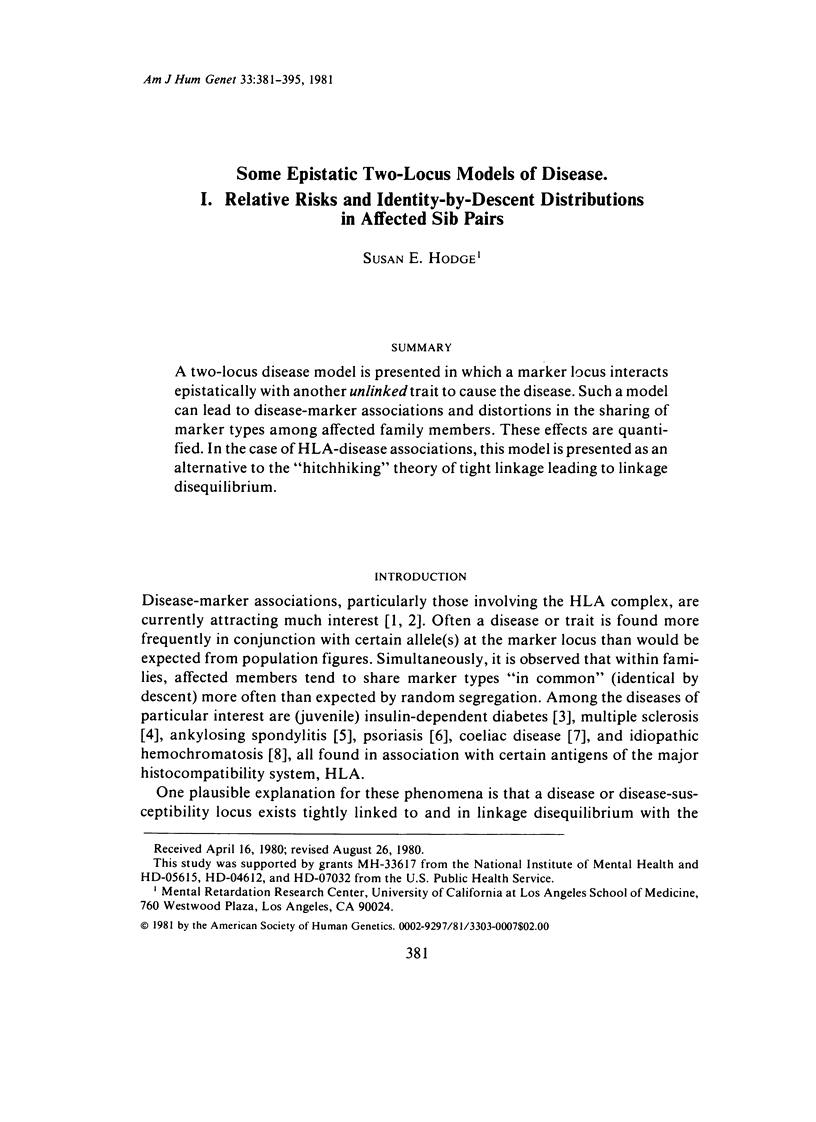
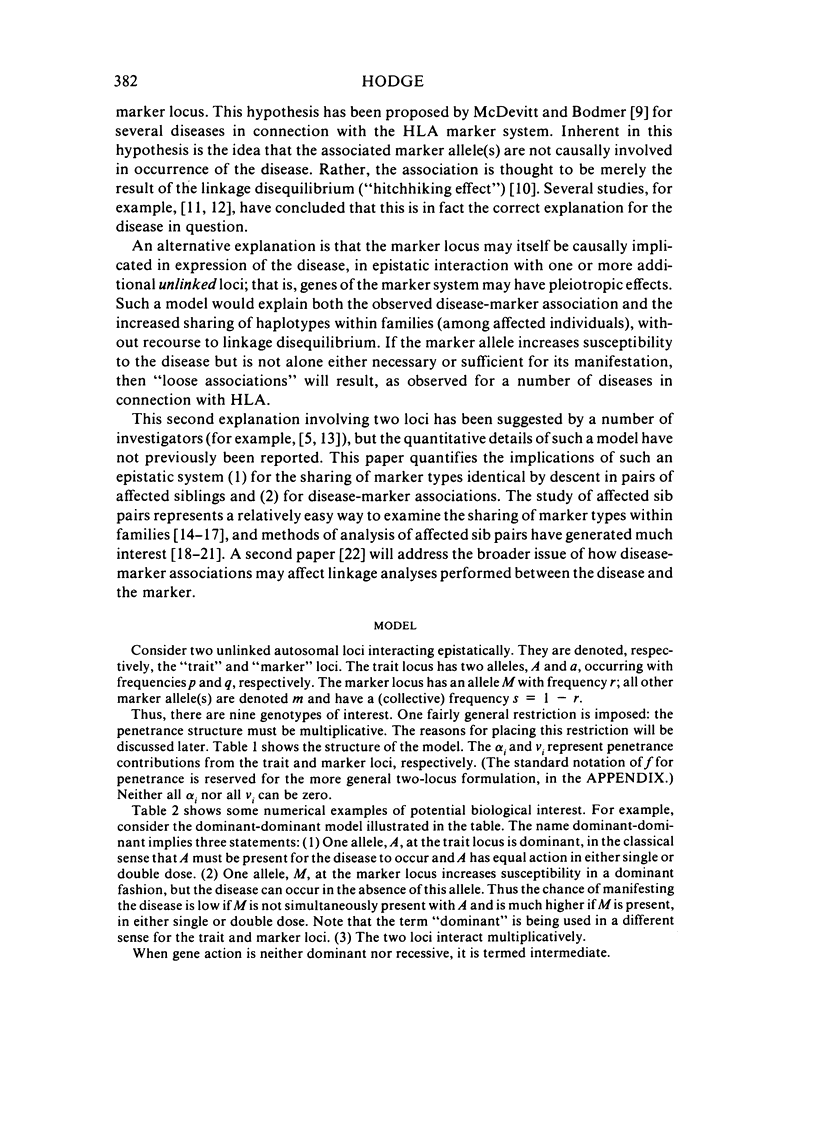
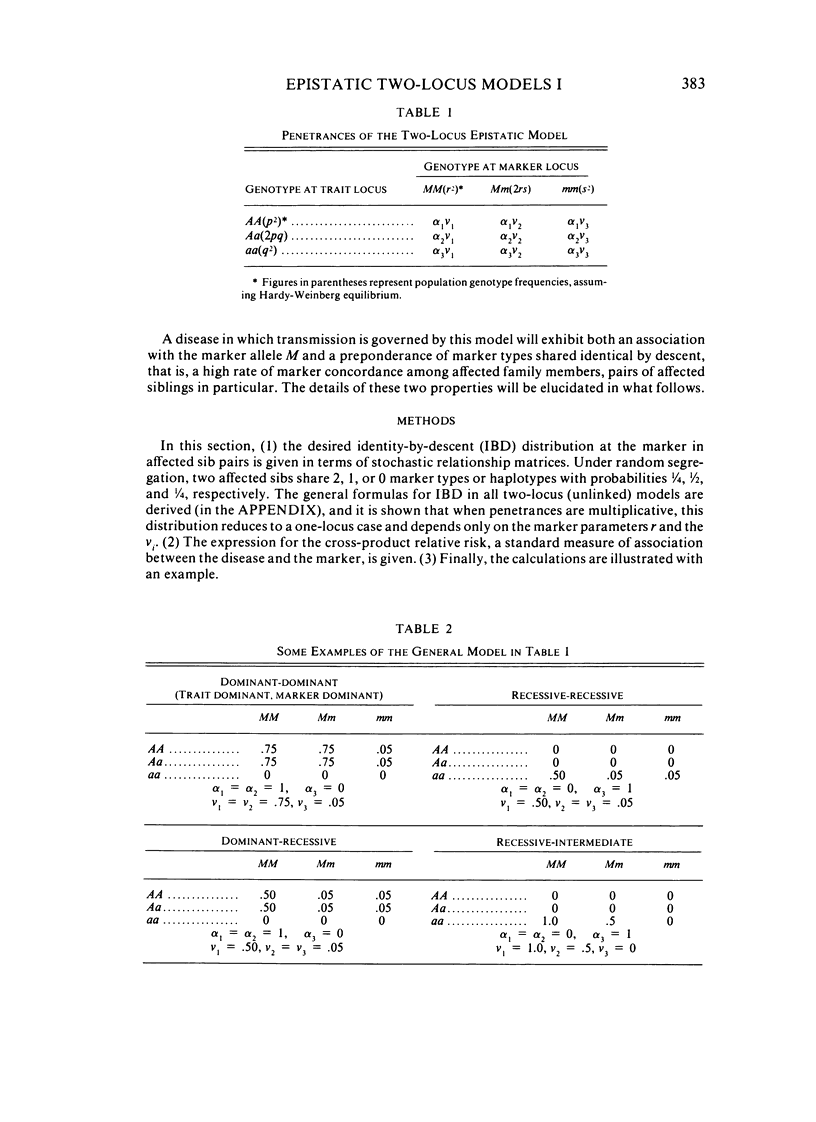
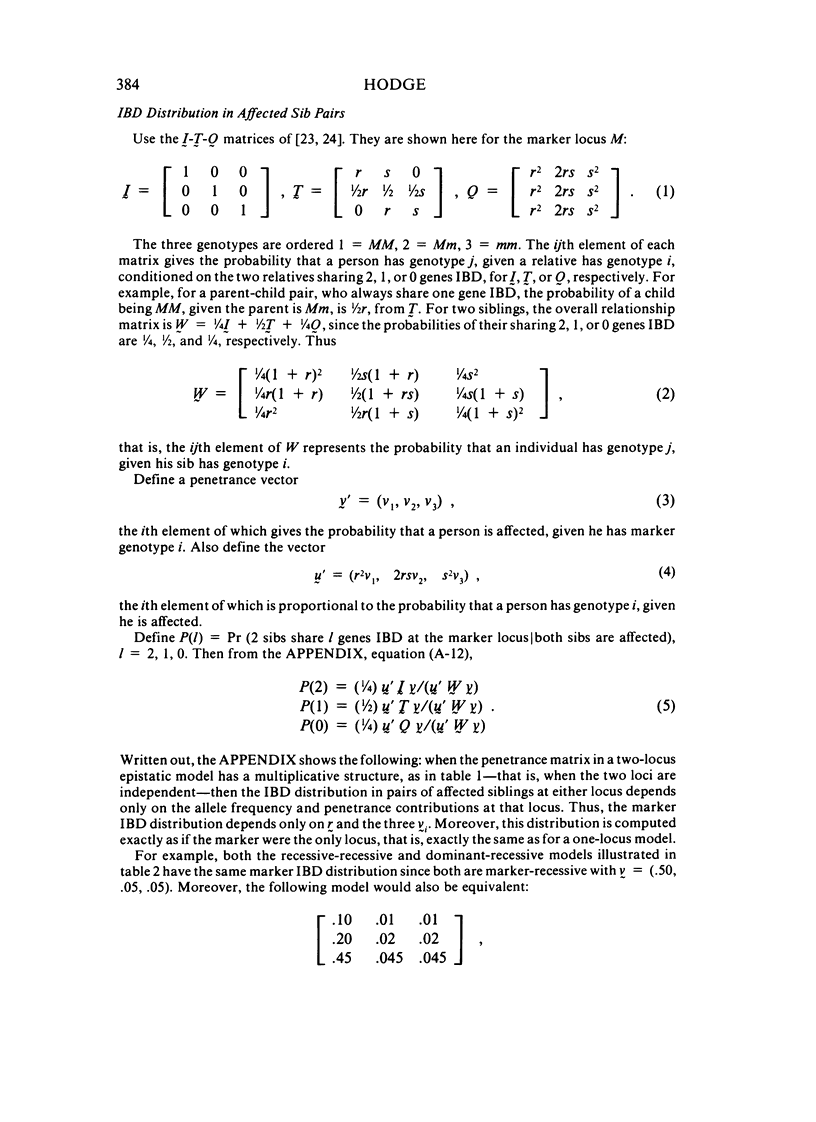

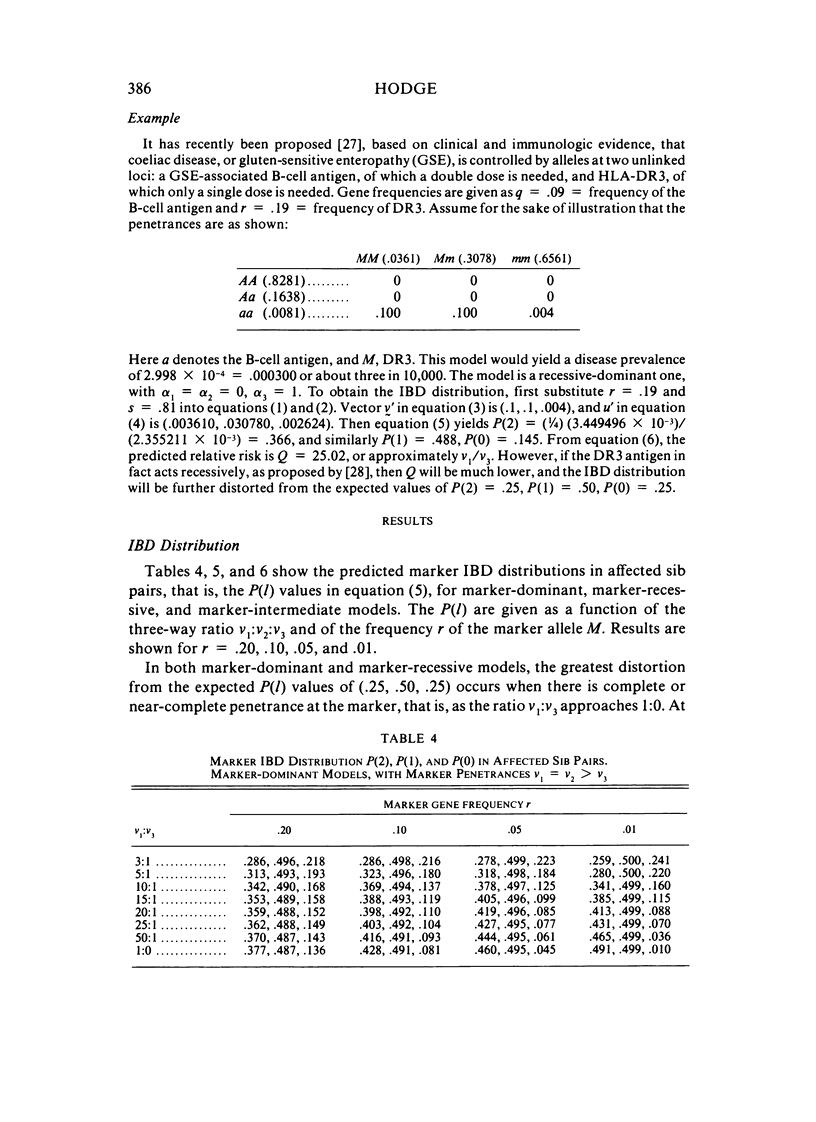



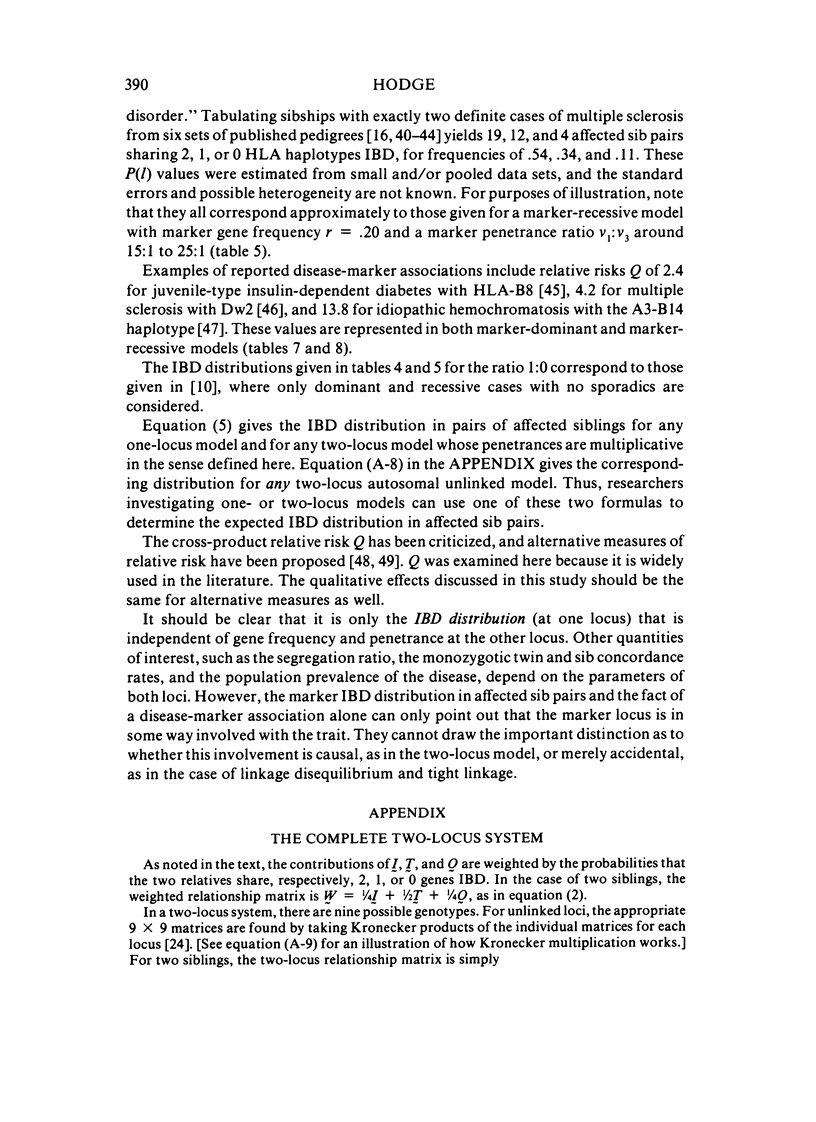


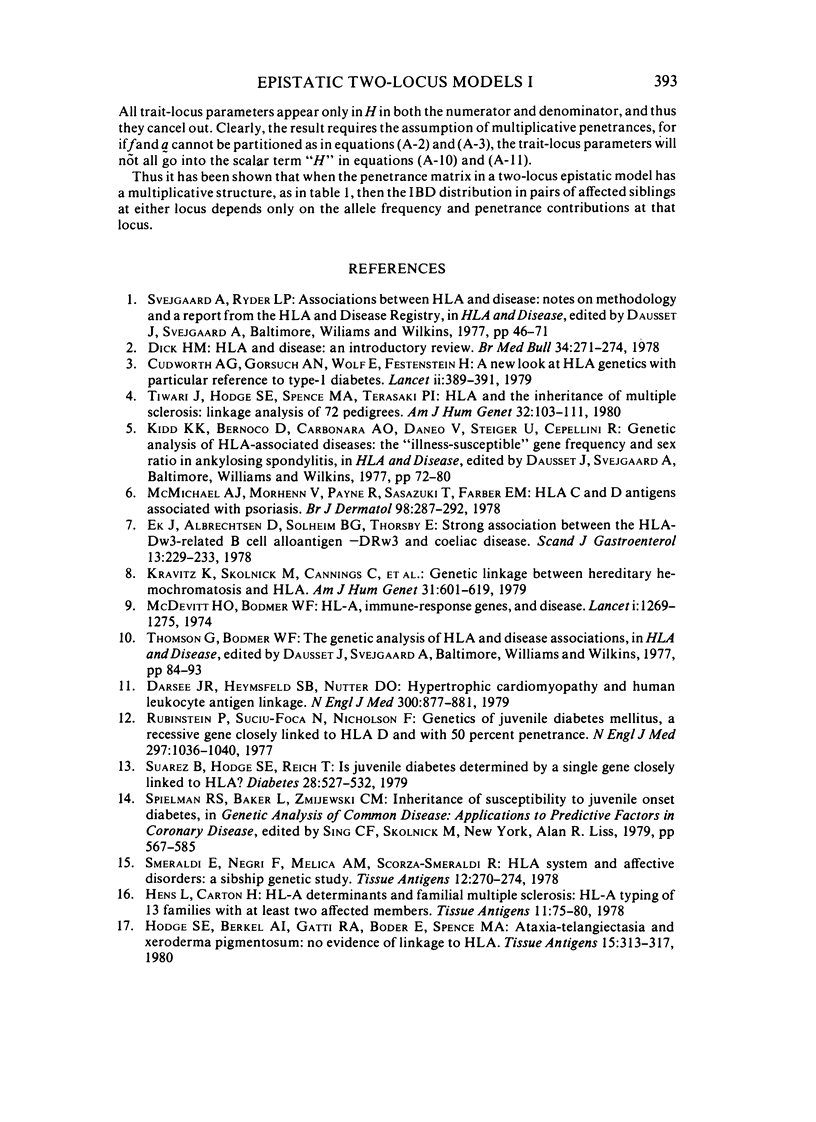
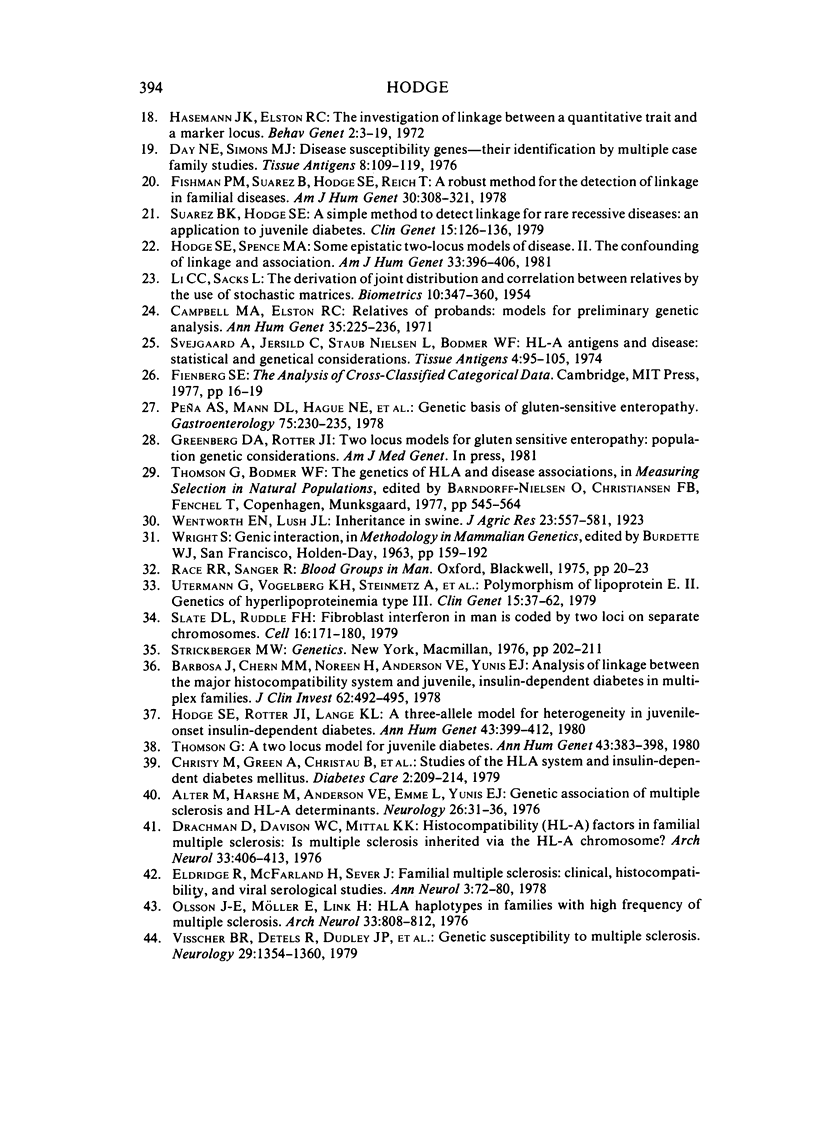

Selected References
These references are in PubMed. This may not be the complete list of references from this article.
- Alter M., Harshe M., Anderson V. E., Emme L., Yunis E. J. Genetic association of multiple sclerosis and HL-A determinants. Neurology. 1976 Jan;26(1):31–36. doi: 10.1212/wnl.26.1.31. [DOI] [PubMed] [Google Scholar]
- Barbosa J., Chern M. M., Noreen H., Anderson V. E. Analysis of linkage between the major histocompatibility system and juvenile, insulin-dependent diabetes in multiplex families. Reanalysis of data. J Clin Invest. 1978 Aug;62(2):492–495. doi: 10.1172/JCI109151. [DOI] [PMC free article] [PubMed] [Google Scholar]
- Batchelor J. R., Compston A., McDonald W. I. The significance of the association between HLA and multiple sclerosis. Br Med Bull. 1978 Sep;34(3):279–284. doi: 10.1093/oxfordjournals.bmb.a071512. [DOI] [PubMed] [Google Scholar]
- Campbell M. A., Elston R. C. Relatives of probands: models for preliminary genetic analysis. Ann Hum Genet. 1971 Oct;35(2):225–236. doi: 10.1111/j.1469-1809.1956.tb01395.x. [DOI] [PubMed] [Google Scholar]
- Christy M., Green A., Christau B., Kromann H., Nerup J., Platz P., Thomsen M., Ryder L. P., Svejgaard A. Studies of the HLA system and insulin-dependent diabetes mellitus. Diabetes Care. 1979 Mar-Apr;2(2):209–214. doi: 10.2337/diacare.2.2.209. [DOI] [PubMed] [Google Scholar]
- Cudworth A. G., Wolf E., Gorsuch A. N., Festenstein H. A new look at HLA genetics with particular reference to type-1 diabetes. Lancet. 1979 Aug 25;2(8139):389–391. doi: 10.1016/s0140-6736(79)90404-5. [DOI] [PubMed] [Google Scholar]
- Curie-Cohen M. A note of relative risks. Tissue Antigens. 1977 Jan;9(1):59–61. [PubMed] [Google Scholar]
- Darsee J. R., Heymsfield S. B., Nutter D. O. Hypertrophic cardiomyopathy and human leukocyte antigen linkage: differentiation of two forms of hypertrophic cardiomyopathy. N Engl J Med. 1979 Apr 19;300(16):877–882. doi: 10.1056/NEJM197904193001602. [DOI] [PubMed] [Google Scholar]
- Day N. E., Simons M. J. Disease susceptibility genes--their identification by multiple case family studies. Tissue Antigens. 1976 Aug;8(2):109–119. [PubMed] [Google Scholar]
- Dick H. M. HLA and disease. Introductory review. Br Med Bull. 1978 Sep;34(3):271–274. doi: 10.1093/oxfordjournals.bmb.a071510. [DOI] [PubMed] [Google Scholar]
- Drachman D. A., Davison W. C., Mittal K. K. Histocompatibility (HL-A) factors in familial multiple sclerosis. Is multiple sclerosis susceptibility inherited via the HL-A chromosome? Arch Neurol. 1976 Jun;33(6):406–413. doi: 10.1001/archneur.1976.00500060012004. [DOI] [PubMed] [Google Scholar]
- Ek J., Albrechtsen D., Solheim B. G., Thorsby E. Strong association between the HLA-Dw3-related B cell alloantigen -DRw3 and coeliac disease. Scand J Gastroenterol. 1978;13(2):229–233. doi: 10.3109/00365527809181753. [DOI] [PubMed] [Google Scholar]
- Eldridge R., McFarland H., Sever J., Sadowsky D., Krebs H. Familial multiple sclerosis: clinical, histocompatibility, and viral serological studies. Ann Neurol. 1978 Jan;3(1):72–80. doi: 10.1002/ana.410030111. [DOI] [PubMed] [Google Scholar]
- Fauchet R., Genetet N., Genetet B., Simon M., Bourel M. HLA determinants in idiopathic hemochromatosis. Tissue Antigens. 1979 Jul;14(1):10–14. doi: 10.1111/j.1399-0039.1979.tb00815.x. [DOI] [PubMed] [Google Scholar]
- Fishman P. M., Suarez B., Hodge S. E., Reich T. A robust method for the detection of linkage in familial disease. Am J Hum Genet. 1978 May;30(3):308–321. [PMC free article] [PubMed] [Google Scholar]
- Haseman J. K., Elston R. C. The investigation of linkage between a quantitative trait and a marker locus. Behav Genet. 1972 Mar;2(1):3–19. doi: 10.1007/BF01066731. [DOI] [PubMed] [Google Scholar]
- Hens L., Carton H. HL-A determinants and familial multiple sclerosis: HL-A typing of 13 families with at least two affected members. Tissue Antigens. 1978 Jan;11(1):75–80. doi: 10.1111/j.1399-0039.1978.tb01230.x. [DOI] [PubMed] [Google Scholar]
- Hodge S. E., Berkel A. I., Gatti R. A., Boder E., Spence M. A. Ataxia-telangiectasia and xeroderma pigmentosum: no evidence of linkage to HLA. Tissue Antigens. 1980 Mar;15(3):313–317. doi: 10.1111/j.1399-0039.1980.tb00922.x. [DOI] [PubMed] [Google Scholar]
- Hodge S. E., Rotter J. I., Lange K. L. A three-allele model for heterogeneity of juvenile onset insulin-dependent diabetes. Ann Hum Genet. 1980 May;43(4):399–409. doi: 10.1111/j.1469-1809.1980.tb01573.x. [DOI] [PubMed] [Google Scholar]
- Hodge S. E., Spence M. A. Some epistatic two-locus models of disease. II. The confounding of linkage and association. Am J Hum Genet. 1981 May;33(3):396–406. [PMC free article] [PubMed] [Google Scholar]
- Kravitz K., Skolnick M., Cannings C., Carmelli D., Baty B., Amos B., Johnson A., Mendell N., Edwards C., Cartwright G. Genetic linkage between hereditary hemochromatosis and HLA. Am J Hum Genet. 1979 Sep;31(5):601–619. [PMC free article] [PubMed] [Google Scholar]
- McDevitt H. O., Bodmer W. F. HL-A, immune-response genes, and disease. Lancet. 1974 Jun 22;1(7869):1269–1275. doi: 10.1016/s0140-6736(74)90021-x. [DOI] [PubMed] [Google Scholar]
- McMichael A. J., Morhenn V., Payne R., Sasazuki T., Farber E. M. HLA C and D antigens associated with psoriasis. Br J Dermatol. 1978 Mar;98(3):287–292. doi: 10.1111/j.1365-2133.1978.tb06155.x. [DOI] [PubMed] [Google Scholar]
- Olsson J. E., Möller E., Link H. HLA haplotypes in families with high frequency of multiple sclerosis. Arch Neurol. 1976 Dec;33(12):808–812. doi: 10.1001/archneur.1976.00500120012002. [DOI] [PubMed] [Google Scholar]
- Peña A. S., Mann D. L., Hague N. E., Heck J. A., van Leeuwen H. A., van Rood J. J., Strober W. Genetic basis of gluten-sentitive enteropathy. Gastroenterology. 1978 Aug;75(2):230–235. [PubMed] [Google Scholar]
- Rotter J. I., Rimoin D. L. Heterogeneity in diabetes mellitus--update, 1978. Evidence for further genetic heterogeneity within juvenile-onset insulin-dependent diabetes mellitus. Diabetes. 1978 May;27(5):599–605. doi: 10.2337/diab.27.5.599. [DOI] [PubMed] [Google Scholar]
- Rubinstein P., Suciu-Foca N., Nicholson J. F. Genetics of juvenile diabetes mellitus. A recessive gene closely linked to HLA D and with 50 per cent penetrance. N Engl J Med. 1977 Nov 10;297(19):1036–1040. doi: 10.1056/NEJM197711102971905. [DOI] [PubMed] [Google Scholar]
- Slate D. L., Ruddle F. H. Fibroblast interferon in man is coded by two loci on separate chromosomes. Cell. 1979 Jan;16(1):171–180. doi: 10.1016/0092-8674(79)90198-3. [DOI] [PubMed] [Google Scholar]
- Smeraldi E., Negri F., Melica A. M., Scorza-Smeraldi R. HLA system and affective disorders: a sibship genetic study. Tissue Antigens. 1978 Oct;12(4):270–274. doi: 10.1111/j.1399-0039.1978.tb01334.x. [DOI] [PubMed] [Google Scholar]
- Suarez B. K., Hodge S. E. A simple method to detect linkage for rare recessive diseases: an application to juvenile diabetes. Clin Genet. 1979 Feb;15(2):126–136. doi: 10.1111/j.1399-0004.1979.tb01751.x. [DOI] [PubMed] [Google Scholar]
- Suarez B., Hodge S. E., Reich T. Is juvenile diabetes determined by a single gene closely linked to HLA? Diabetes. 1979 Jun;28(6):527–532. doi: 10.2337/diab.28.6.527. [DOI] [PubMed] [Google Scholar]
- Svejgaard A., Jersild C., Nielsen L. S., Bodmer W. F. HL-A antigens and disease. Statistical and genetical considerations. Tissue Antigens. 1974;4(2):95–105. doi: 10.1111/j.1399-0039.1974.tb00230.x. [DOI] [PubMed] [Google Scholar]
- Thomson G. A two locus model for juvenile diabetes. Ann Hum Genet. 1980 May;43(4):383–398. doi: 10.1111/j.1469-1809.1980.tb01572.x. [DOI] [PubMed] [Google Scholar]
- Tiwari J. L., Hodge S. E., Terasaki P. I., Spence M. A. HLA and the inheritance of multiple sclerosis: linkage analysis of 72 pedigrees. Am J Hum Genet. 1980 Jan;32(1):103–111. [PMC free article] [PubMed] [Google Scholar]
- Utermann G., Vogelberg K. H., Steinmetz A., Schoenborn W., Pruin N., Jaeschke M., Hees M., Canzler H. Polymorphism of apolipoprotein E. II. Genetics of hyperlipoproteinemia type III. Clin Genet. 1979 Jan;15(1):37–62. [PubMed] [Google Scholar]
- Visscher B. R., Detels R., Dudley J., Haile R. W., Malmgren R. M., Terasaki P. I., Park M. S. Genetic susceptibility to multiple sclerosis. Neurology. 1979 Oct;29(10):1354–1360. doi: 10.1212/wnl.29.10.1354. [DOI] [PubMed] [Google Scholar]


